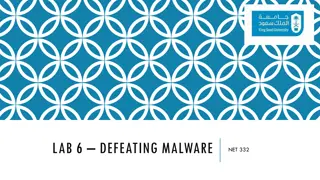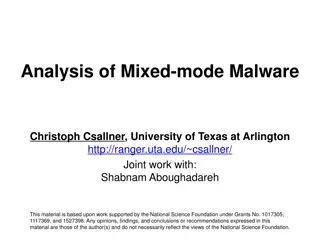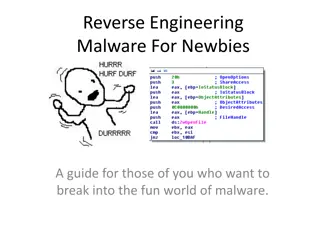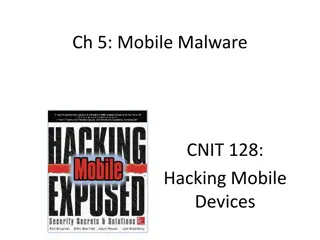Analyzing Android Applications for Malware Detection
Android applications have become a prime target for cybercriminals, leading to an increase in Android malware. The authors introduce a mobile sandbox for automated analysis of Android apps, combining both static and dynamic methods. Static analysis inspects downloaded apps and their source code, while dynamic analysis runs apps in a secure environment to log their operations. The approach matches hash values with malware databases, extracts apps, analyzes permissions, and examines Dalvik bytecode for dangerous functions. By filtering out unnecessary function calls and analyzing coded URLs, this method aims to detect and prevent malicious activities. The process culminates in the creation of an informative XML file. An Android emulator is utilized for app analysis.
Download Presentation

Please find below an Image/Link to download the presentation.
The content on the website is provided AS IS for your information and personal use only. It may not be sold, licensed, or shared on other websites without obtaining consent from the author.If you encounter any issues during the download, it is possible that the publisher has removed the file from their server.
You are allowed to download the files provided on this website for personal or commercial use, subject to the condition that they are used lawfully. All files are the property of their respective owners.
The content on the website is provided AS IS for your information and personal use only. It may not be sold, licensed, or shared on other websites without obtaining consent from the author.
E N D
Presentation Transcript
Florian Echtler, Thomas Schreck Siemens CERT Munich, Germany florian.echtler, t.schreck@siemens.co m Johannes Hoffmann Ruhr-University Bochum Bochum, Germany johannes.hoffmann@ru b.de Michael Spreitzenbarth, Felix Freiling Friedrich-Alexander- University Erlangen, Germany michael.spreitzenbart, felix.freiling@cs.fau.de Presented by: Kushal Mehta University of Central Florida
Android applications are becoming the focus of cyber criminals in the recent years. With an increase the number of android applications, android malware is also increasing at a very high rate. The authors present mobile-sandbox which is a novel way to auto analyze android applications.
Static: Investigates the properties that can be investigated by inspecting the downloaded app and its source code only. Eg: Signature based inspection used by anti-virus technologies. Dynamic: In this method, app is run in a secure environment such as sand-box and logs every relevant operation of the app.
Static analysis method can countered easily by making function calls to libraries outside the Dalvik/ Java runtime library. Dynamic analysis is a little harder to counter but still can be worked around during runtime The author s approach combines both static and dynamic methods to analyze apps.
Hash value is matched with VirusTool database and classified into existing malware families. The app is then extracted and all the required permissions are analyzed by using aapt tool. Now Dalvik byte code is converted to Smali. While doing so, the advertising networks are removed. Then analyze entire smali code for dangerous functions such as sendTextMessage() , getPackageInfo(), getSimCountryIso().
The frequency of such function calls is taken into account. A code-review step is performed to understand which calls are necessary for the app to work correctly. Statistically coded URL are analyzed and all the implemented timers are broadcasts are filtered out. By the end of static analysis, an XML file is created with all the information .
An android emulator provided by google is used to perform app analysis. But the emulator has limited logging capability hence it is patched with DroidBox. Logs contain information such as data written to and read from files, sent ad received over the network, SMS messages sent and so on.
Native code using JNI is invisible to DroidBox. The android NDK allows function calls to be made to external libraries. Functions such as socket(), connect(), read(), write() can be potentially used by malware to communicate with external server. Modified ltrace is used to trace native function calls which attaches to Dalvik VM and logs the information.
This is the third logging component and is already supported by the emulator. The logging information is saved in a PCAP file This file can be later analyzed using tools such as WireShark.
It is necessary for the user to interact in a certain way with the app to trigger the malware. MonkeyRunner toolkit is used which emulates random user interactions and is provided by the Android SDK. Other random events are also generated externally such as receiving calls or text messages.
Reset emulator to the initial state. Launch emulator and wait until startup is completed. Install app to be analyzed. Launch app in a new Dalvik VM. Attach ltrace to the VM process running the app. Launch MonkeyRunner to generate simulated UI events. Simulate additional user events like phone calls. Launch a second run of MonkeyRunner. Collect the Dalvik and ltrace log and the PCAP file.
20 samples were randomly chosen from a set of malicious apps. Then the authors manually inspected elements from other malware families known from other virus databases. It turned out that mobile sand-box detected the malware that were included in the dataset.
Performance of the application is rather weak and runtimes were between 9 to 14 minutes. The majority of this time is taken up in installing the application and using the MonkeyRunner script. Performance can be improved by running multiple instances of analysis frameworks simultaneously
Android applications in future will become increasingly aware if they are running on an emulator or the real device This detection is done by using certain values of the device such as device build, model, kernel. The authors tried to change these parameters on the emulator to see if the malicious apps cannot detect the emulator.
Mobile sandbox was used to analyze 36,000 randomly chosen apps and 4000 randomly chosen apps from the malware set. Mobile sandbox detected a total of 4641 malicious apps. Out of the 36000 apps chosen, 641 were detected to be malicious.
Total percentage of malicious apps detected from the dataset is 1.78% (641 out of 36000 ) Out of these, as many as 35 apps were not detected as malicious by other anti-virus software. The performance of mobile sandbox still needs to be vastly improved but it has a better rate of detection than other virus detection software.























